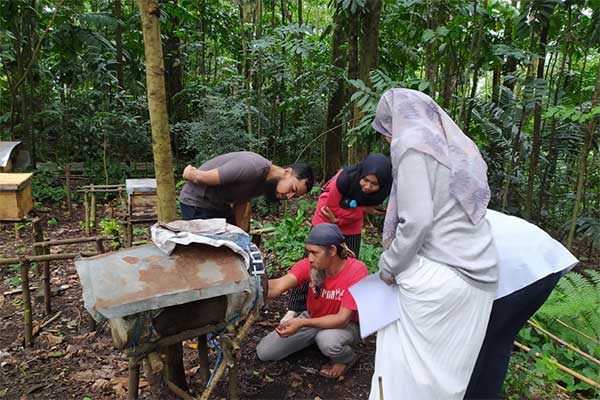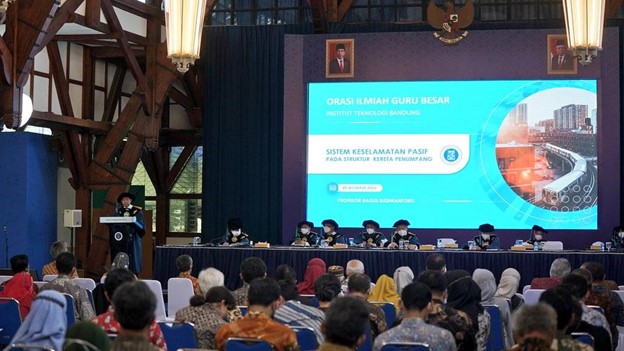Applying Palynology in West Java's Honey Production
By Adi Permana
Editor Adi Permana

BANDUNG, itb.ac.id – ITB is well-known for its enthusiasm for innovation and often held research collaborations with other organizations to help nearby communities. One of the recent collaborations is investigating the relationship between pollen and the local honey production in West Java.
This research was led by the Geological Engineer professor Dr.rer.nat. Maria Sekar Proborukmi, S.T., M.Sc. who was part of the Paleontology and Quaternary Geology Research Group. Her research was assisted by two postgraduate geological engineering students Nadila Novandaru (doctoral student) and Wildan Nur Hamzah (magistrate student).
The research aims to implement one of palynology's analysis strategies to raise local honey's competitive advantage in the market, specifically in Bandung and nearby regions. It was funded by LPPM ITB, following the 2020 P3MI community service plans of the Paleontology and Quaternary Geology Research Group.
“Palynology is the study that delves into pollens and spores. They are classified as sporomorph- high resistant members of the palynomorph group made of organic materials. Because of these characteristics, they can be deposited as fine grains, organic sediments in the form of coal, stalactite or stalagmite, and evaporite rocks. The analysis is done by studying the pollens of modern plants,” Dr. Maria explained, as quoted in the ITB Rekacipta rubric of Media Indonesia published on 11 January 2022.
Pollens can be found at flowering plants and carried away by bees that feed on nectar. These pollens will accumulate into honey. In Maria's research, the concept of melissopalynology is applied in which pollens in honey are analyzed.
This research offers essential information regarding the contents of pollen in honey to local beekeepers. The method implemented is the fastest and cheapest in determining the contents of nectar-producing flowers and the geographic origin of honey. Beekeepers can then figure out the honey's production time, conservation of nectar-producing plants, ecosystem restoration efforts, branding, and ideal locations for optimal cultivation that increases its production rate. Moreover, the information can serve as proof of honey's authenticity and quality to ensure they do not contain allergens, ascertaining safe consumption and exportation.
During her research, Maria and her team investigated five apiaries in Bandung and nearby regions: Madu Maribaya Sari Alam Legend Bee, Madu THR Juanda, Syifa Madu, D-Bee'S Lestari Apiari, and Bandar Madu Syariah Pangalengan. Both beekeeping and honey-harvesting processes are done at sites with undulating topography, such as hills, volcanic mountains, protected forests, as well as others with an altitude between 1300-2100 meters above sea level and covered by volcanic minerals from previous eruptions.
From the five apiaries, 18 samples were obtained in the form of bowl honey, honeycomb, bee pollen, and bee droppings from trees around the farm. The honey samples were obtained from the Apis cerana, Trigona, Apis dorsata, and Apis melifera bees.
“The collected samples are prepared with the standard procedure set by the Paleontology Laboratory of ITB Geological Engineering Study Program. They are then examined with microscopes to determine the type of plants based on the pollens observed in each sample. The result reveals that the plant composition varies in each sample despite some originating from the same farm,” Maria recalled.
From the experiment, Maria deduced that pollens can be identified from their origin plants' family-level taxonomy such as Arecaceae, Myrtaceae, Onagraceae, Cerealia, Amaranthaceae, Fabaceae, Oleaceae, Malvaceae, and Pinaceae.
Other pollens can be further identified to their Genus levels like Acacia, Calliandra, Saurauia, Casuarina, Persea, and Annona. Some vegetation found can also be specified until the taxonomy level of species such as Mangifera indica, Citrus sinensis, and Asteraceae tubuliflorae.
The results of this research were compiled into a book titled “Applying Melissopalynology on West Java’s Local Honey”. Aside from the book being published by ITB Press, Maria and her team designed posters and standing banners with details of the analysis results for local beekeepers.
Thanks to Maria’s research in 2020, she received offers for joint research till today. Presently, her team collaborated with the P2Par ITB unit to study honey produced by Mekarwangi Village, Sindangkerta. They can continue their research from a job offer sent by a mining and metal company as well as the KKP ITB's marketing of local honey.
Although Maria is currently focused on the Mekarwangi Village research, she mentioned that she would like to design a scheme that assists beekeepers in receiving information about pollen contents in their harvested honey. Before the project comes to fruition, beekeepers and honey producers can discuss it with her via email (maria@itb.ac.id).
By publicizing the information, Maria and her team hoped that local beekeepers can utilize it for branding, packaging, and marketing purposes of local honey production to boost its sale.
Reporter: Pravito Septadenova Dwi Ananta (Teknik Geologi, 2019)
Translator: Ruth Nathania (Teknik Lingkungan, 2019)

.jpg)
.jpg)
.jpg)
.jpg)
.jpg)


